Goji Berry growing in South Africa
The market for this exceptionally highly nutritional and valued berry is increasingly growing worldwide. The South African market also tends to start to focus more on organic and healthier products, where sources such as Goji perfectly fit in.
Introduction:
As with some other healthy fruit and berries such as Pomegranates, Cranberries, Blueberries and Raspberries, Goji berries are way at the top regarding their ORAC (Oxygen Radical Absorbance Capacity) and other valuable vitamins and nutrients such as vitamin A and C, Protein, Thiamine, Riboflavin, Iron, Selenium, Copper, Potassium and Calcium.
Goji, Wolfberry, Lycium Barbarum, Lycium Chinese are all names given to plants currently marketed around the world. All of these names refer to plants in the genus Lycium.
Description
Goji is a sprawling shrub with long, flexible canes and clusters of small, greyish to green leaves. The flowers are a brilliant royal purple and they appear in late spring to early summer. They give way to juicy, bright red fruits which are sweet, yet slightly resembling the taste of raisins, raspberries and dates. They grow sweeter as they mature on the plant.
The plant will produce fruit in its second year and reach maturity in its fifth year.
Domestication Projects
Goji is an extremely adaptable and durable plant with many environmental uses. The deep roots draw nutrients and water from deep in the soil and are excellent for mitigating erosion and producing nutrient rich food in areas of the world where depleted soils are no longer useful for traditional agricultural methods.
In developing areas of the world, Goji is becoming a common crop that is capable of producing valuable nutrition on marginal land with minimal inputs. Alkaline soils, such as those commonly found in desert areas are ideal for Goji cultivation with minimal water availability.
Goji plants reduce erosion and increase humus in the top layers of the soil by shedding leaves each winter in areas where it gets cold enough to trigger hibernation in the plant.
Because of their vitality, Goji plants have a tendency to reduce desertification or encroachment of the desert on semi-arid areas by holding onto and increasing the quantity of topsoil in a particular area.
Goji berry uses:
Goji bears edible and very healthy berries, perfect for juicing, teas, soups, jams, tarts, deserts or fresh fruit. Other than its fruit, the complete plant can also be used such as the roots, stems, vines and leaves. There are many medicinal uses and Goji is currently being used in an array of beauty products. It is also made into a powdery form to blend in with liquids such as smoothes, shakes, drinks or other consumption.
Goji berry varieties:
NQ1 strain
Compared to other small fruits and berry crops, there is still very little literature available for Goji. As far as we could gather, there are two main species in the Solanaceae family; Lycium Chinense and Lycium Barbarum. Lycium Chinense is a very diverse family of shrubs that generally live in arid environments and usually have edible berries.
The most common type of Goji is the N1 or NQ1 type. Berries from this type are cylindrical and are generally a lighter colour red. This is the strain that is under constant development by the agricultural industry in and around the Ninxia province in China. Modern versions of this strain produce uniform berries with a larger size and the plants grow rapidly, sometimes producing berries in their first year of growth. Older versions of this strain still exhibit genetic diversity, producing berries with more variation in size, shape and colour.
Nutrition and Health
The goji berry is a leading member of an emerging class of fruits, known as “Superfruits.”
- L. barbarum plant parts, including fruits, leaves, flowers, have long been recognized as a functional food praised in Chinese culture. The berries, in particular, are packed with an impressive list of essential nutrients, anti-oxidants, vitamins, and minerals.
- Dry, red ripe goji berries are concentrated sources of carotenoids, calories, vitamins, and minerals.
- Antioxidant carotenoids and flavonoids found abundantly in goji berries. Beta-carotene, zeaxanthin, cryptoxanthin, and lutien play vital role in protecting skin and mucus membranes from free radical injury.
- Certain flavonoids found in goji berries are quercetin, kaempferol, myricetin, hesperidin, and rutin. They act as anti-oxidants, anti-inflammatory and anti-cancer agents.
- Zea-xanthin is a natural anti-oxidant which has UV (ultra-violet) rays filtering actions in the macula lutea in retina of the eyes. Thus, it may offer protection from “age-related macular disease” (ARMD) in the elderly.
- Fresh as well as dried goji are an excellent sources of vitamin A. 100 g of dried berries carry astoundingly 26822 IU of vitamin A. Vitamin A is a powerful natural anti-oxidant and is required by the body for maintaining the integrity of skin and mucusa. It is also an essential vitamin for good vision. Research studies suggest that natural foods rich in vitamin A may help human body protect against lung and oral cavity cancers.
- Vitamin C is another natural anti-oxidant found in good concentration in goji. 100 grams of dried goji composes 48.4 mg or 80% of daily required levels of this vitamin.
- Dried gojiberries are excellent source of calcium (190 mg or 19% of RDI), iron 6.80 mg/100 g of fruits (about 85% of RDI). Iron, being a component of hemoglobin inside the red blood cells, determines the oxygen-carrying capacity of the blood. Calcium is an important mineral that is an essential constituent of bone and teeth, and required by the body for muscle contraction, blood clotting, and nerve impulse conduction.
- Further, fresh as well as dry berries carry adequate daily recommended levels of B-complex group of vitamins. Dried goji contains very good amounts of pyridoxine (vitamin B-6), thiamin niacin, pantothenic acid, and riboflavin. These vitamins are acting as cofactors help body metabolize carbohydrates, protein, and fats.
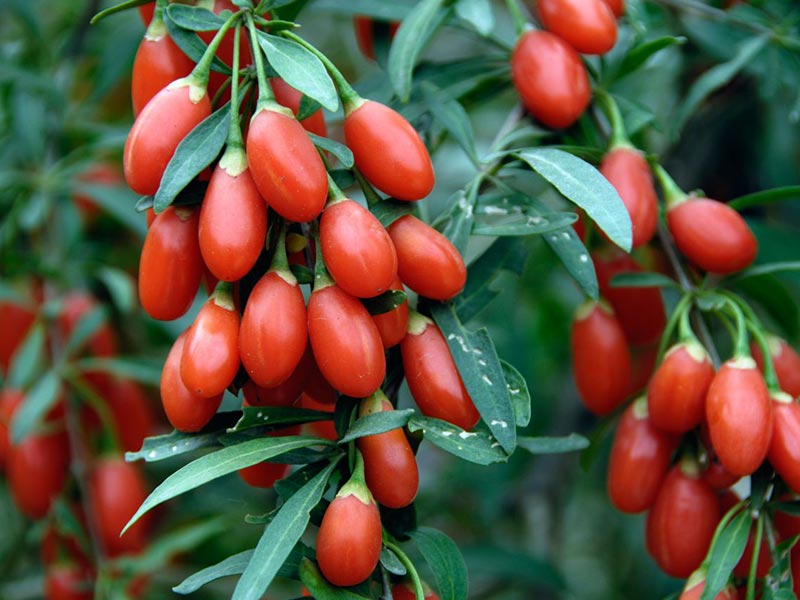
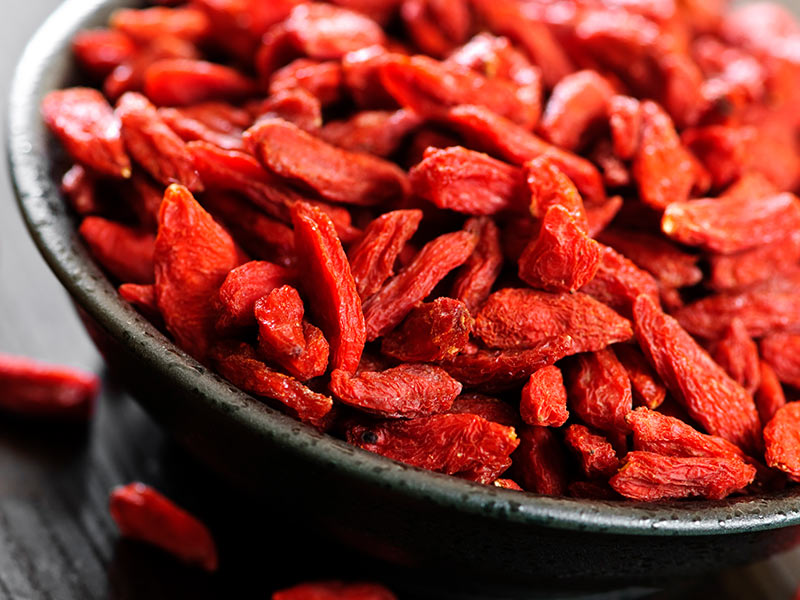
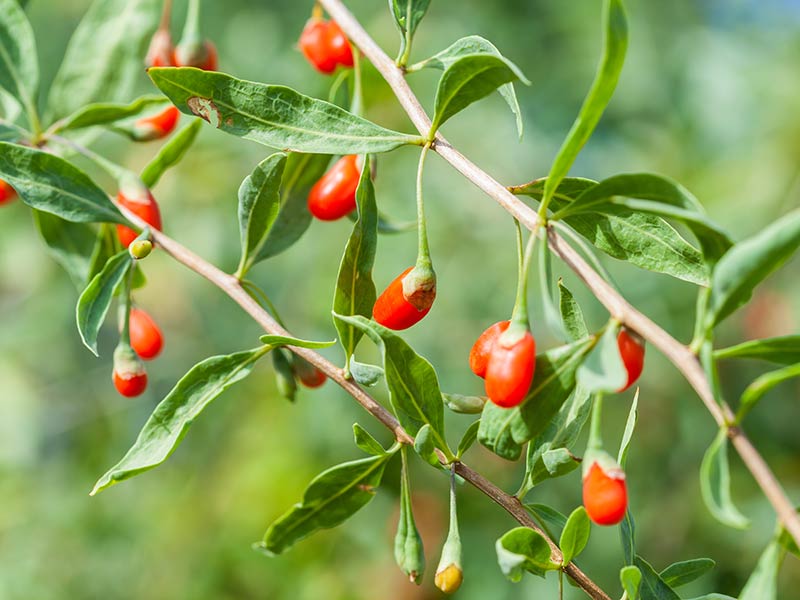
Site selection and preparation:
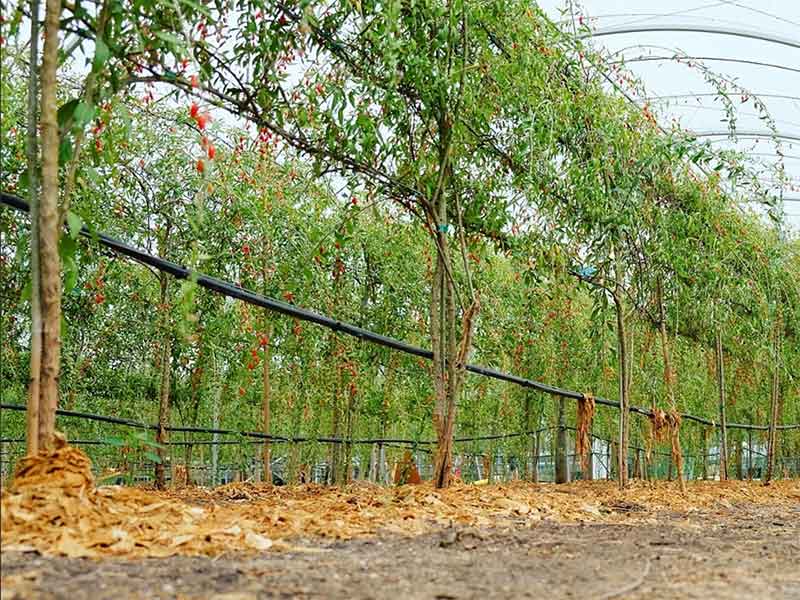 Goji is a tall rambling plant which can be placed in full sun but also tolerates partly shade. It can be planted in an array of soil and climate conditions. The plant is extremely cold hardy and heat tolerant and can survive temperatures between -40°C to 38°C. It can be grown in a wide soil PH level between 6.5 and 8.5. It prefers sandy to loamy soil that is well-drained as the plant does not grow well in soggy conditions. The plant needs to be staked during the first year or two.
Goji is a tall rambling plant which can be placed in full sun but also tolerates partly shade. It can be planted in an array of soil and climate conditions. The plant is extremely cold hardy and heat tolerant and can survive temperatures between -40°C to 38°C. It can be grown in a wide soil PH level between 6.5 and 8.5. It prefers sandy to loamy soil that is well-drained as the plant does not grow well in soggy conditions. The plant needs to be staked during the first year or two.
The Goji berry plant grows into a large shrub reaching heights of 2.5 – 3.0m, with vines that can reach up to 2 meters. Pruning the main stem and branches will keep the plant shorter, thicker and help with increased flowering and fruit production.
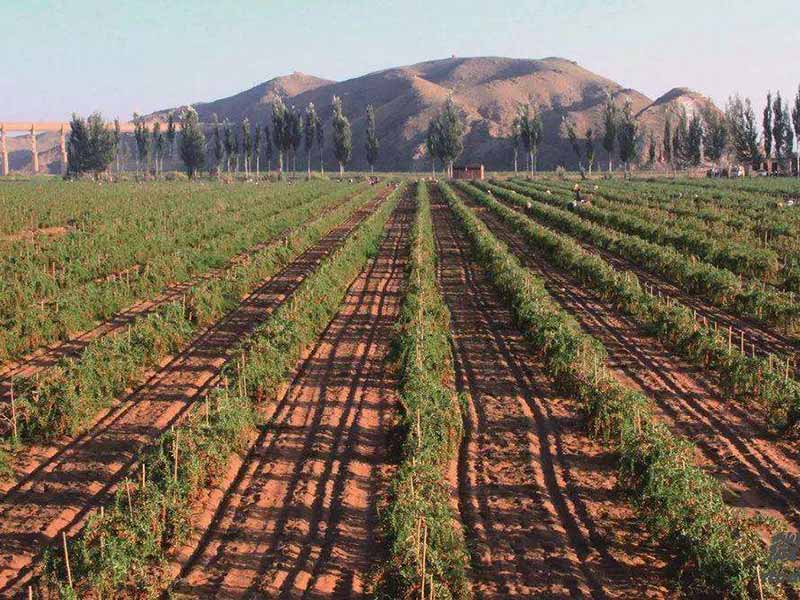
Spacing
Planting of Goji is performed during spring or the summer. Before planting, the land must be levelled, cultivated and marked. When developing large scale plantations with machine cultivation, it is recommended to use a plant spacing of 1.3m – 1.8m and 1.8 – 2.5m for spacing between the rows. For small plantations and home gardens, the distance is shortened up to 1.0 between plants and 1.5m between the rows.
Newly planted plants should be kept moist until they are established and well leafed out. Thereafter they become can become very drought hardy and require little water.
A planning hole can be made at a size of 30cm x 30cm x30cm.
In general, good quality compost or well rotted manure (1.0-2.0kg) and a small hand full of bone meal (about 30g) can be added to the bottom of the planting hole, but make sure to backfill the hole a bit with the sandy soil in order for the roots not to touch the compost/manure. There are also good organic complete fertilizers on the market such as the VitaGrow 2:3:2 from Talborne Organics which works well to add to the planting hole before planting. Care must be taken to follow the application directions as too much fertilizer can burn the roots.
Interesting Fact:
A Chinese study published in the Chinese Journal of Oncology in 1994 found that 79 people with cancer responded better to treatment when goji was added to their regimen.
Irrigation
Goji plants are drought resistant after a couple of years of hardening and do not require much water, but care must be taken to keep the soil moist with new plantings especially when young plants are transplanted in the summer. Irrigation in plantations can be applied with drip systems or overhead sprinklers.
Container Growing
Goji will also grow and fruit well in a container, just be sure to choose one large enough as it should be at least 40cm in diameter and 50cm high. The container also needs to have a draining hole. A good planting medium is a sandy to loamy soil mixed with a bit of compost or potting soil.
Fertilising your Goji plants
Goji is a very strong plant that usually requires very little attention once established. It does however need certain nutrients to thrive to produce optimum yields.
Organic Fertilizer:
Organic fertilizer is generally the safest for your plants, although it will sometimes take longer to see results since most organic fertilizers release slowly over time. There are a couple of organic slow release fertilizers currently on the market, but we have tested the VitaFruit 3:1:5 from Talborne Organics which works well, but only a small amount is generally needed such as 30-50g during the growing season depending on the size of the plant.
Chemical Fertilizer:
Chemical fertilizers are not inherently bad. Chemical fertilizers are an incredibly efficient way to transport nutrients for plants and are easier to apply with precision using modern agricultural equipment then organic types of fertilizers.
If you do choose to use chemical fertilizers, caution must be taken as many of the commercially available fertilizer mixes are formulated with Muriate of Potash (MoP) as a source of Potassium. MoP is composed of chlorine and potassium. Chlorine is bad for the soil and will reduce the healthy populations of bacteria and mycorrhizae. If you are interested in using chemical fertilizers, mix your own or look for a brand that uses non-chlorine sources of potassium to protect your rhizosphere
PH balancing
Adjusting the pH of your soil can have dramatic effects on the growth of your plants, especially if your soil is acidic. Although Goji can be grown in a wide range of ph levels (6.5 -8.5), optimum growth is best at a ph level between 7.0 and 8.2, which is very alkali. Adding agricultural dolomitic lime to the soil when you are preparing to plant is an excellent way to increase some micronutrients such as calcium and magnesium in the soil while ensuring that the pH is in a good range for optimal nutrient uptake. For larger plantations it is best to have the soil tested to calculate the specific amount of lime needed for ph alterations.
Pruning & Trellising
Goji does not require pruning to grow well and produce fruit, but the plant is more manageable and easier to harvest when its lateral (horizontal) branches are pruned to around one meter in length to encourage branching and the production of vigorous new growth which will establish a bushy plant ready for heavy crop production during late summer. Remove any dead shoots when they appear.
Pruning is also a factor in controlling thorniness as thorns are more prevalent in older growth.
Fruit is borne on the current year’s wood, mainly from that which is grown in the spring and fall. The goals of pruning are to limit plant height, improve ease of harvest, encourage light penetration into the plant, improve foliage drying, and encourage formation of lateral branches to maximize fruit production. Canes that are un-tipped will continue to grow and produce few laterals branches while canes that are headed back will produce more laterals and higher yields. Little research has been conducted to determine the best pruning methods for our region. However, in other production areas, plants usually are limited to one single main stem. Pruning is done during the dormant season to remove spindly canes, remove dead and damaged wood, improve plant shape and shorten laterals. During the summer pruning is done to head back growth, encourage lateral formation, and remove new shoots. One of the most important goals of pruning is to produce an open canopy structure that allows plenty of sunlight infiltration.
Harvesting and storage
The Goji plant begins flowering in the second year with maximum fruit production in the fourth to fifth year. Nutrient values slightly changes as fruit ripens from orange to bright red and also when it is dried. Fully ripe fruit is less bitter, but is very fragile and easily bruised with a shelve life of about a week. Picked fruit is washed and floated in cold water where stems and leaf fragments can be removed. Washed fruit can be used fresh, dried, frozen or processed. Fresh fruit should be refrigerated and can be kept for a week or more in the refrigerator.
Fruit can also be dried in a dehydrator or placed on outdoor drying racks for sun drying. Drying the fruit with a dehydrator at around 35°C will take approximately 3 days. Drying at higher temperatures can destroy some of the nutrients. Berries are sufficiently dry when they reach a raisin-like consistency. They should be stored in airtight containers in a cool, dry environment.
The leaves and young stems are also nutrient loaded, can be harvested and easily stripped to be used in salads, soups, teas or for processing. Stems for vegetable use should still be completely green and show no hard wood. Usually, the tenderest stems are the ones shorter than 15cm. Leaves from the vines can be stored or dried. Dried leaves and stems can be blended into a powder. The best time to harvest the leaves is late fall after the berry harvest. Goji berry plants are deciduous and lose their leaves during winter in colder areas.
Root bark is known to be antibacterial, hypoglycaemic, assist with hepatic encephalopathy and has been used to treat hypertension and diabetes. Root bark is best harvested in early spring. The bark is peeled from the roots and then dried.
If deciding to market Goji berry as fresh fruit in South Africa, one would have the benefit of a niche market as customers can have the option to taste and use the fresh alternative to dried Goji berries. As with most berries, it contains more essential properties and nutrients if used fresh compared to the dried or processed products. Another benefit is that raw Goji berry is naturally sweet and does not need any sweetening treatments such as with prunes or cranberries.
Commercial growing- Yields
The annual yield from Goji berry fruits during its third year is about 2200-2500 kg/ha of dried fruits, and 4000-4500 kg/ha dry fruits during the fifth year. It is recommended to plant Goji with density from 3500 plants per hectare (1.60m between plants with a row spacing of 1.80m). The plants have to be adapted and stabilized before planting in field. Maximum yields of as high as 7500kg of fresh fruit per hectare have been reported in China.
Pests and diseases
Goji berry plants are not affected by many pests and diseases although birds and other wildlife that feed on berries may be attracted. Reports of aphids, thrips and spider mites have been reported.
Limited research in South Africa is done regarding diseases, but other countries report that the following diseases were found on some sites: Anthracnose (Colletotrichum spp.), early blight (Alternaria solani), powdery mildew.

